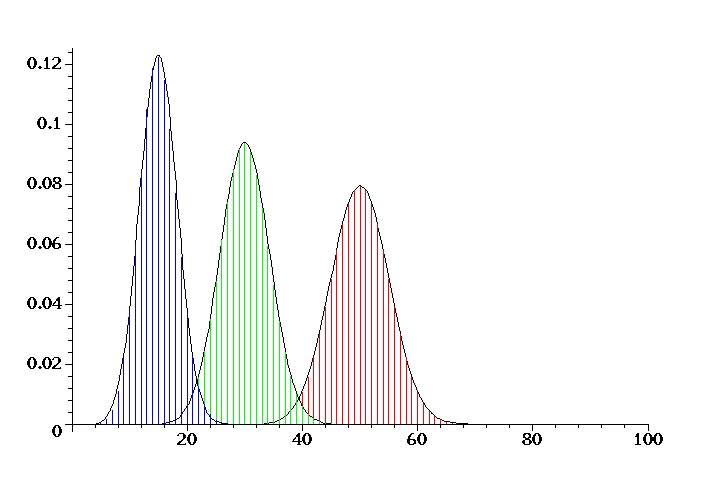Math & Stat 425 / Sections 1 and 2
Introduction to Probability
Winter 2010
- Instructor: John Stembridge
- Office: 4854 East Hall
- Phone: 936-1790
- email: jrs AT umich DOT edu
- Office Hours: M 11-12:30, F 2:00-3:30
We will cover most of Chapters 1-7 and a little of Chapter 8. I will be expecting you to read the relevant sections of the book, and not merely use the text as the place where you look up homework problems. But keep in mind that some of the sections include applications that are too advanced for this course. I'll try to give you specific alerts from time to time.
Prerequisite:
Math 215 or 285 (multi-variable calculus).
The first month or so will be devoted to discrete probability, so it is easy
to get lulled into thinking that you can get by without all of the calculus
you studied years ago. If you don't remember how to deal with double
integrals or related concepts, you'll need to review.
Homework is important!
There will be approximately 10 posted problem sets (see below).
You can turn in assignments either in class or at my office
(4854 East Hall) by 4:00pm of the date due--usually a Monday.
The first homework set will be due on Friday, January 15.
Depending on the number of hours allotted to the grader(s) for these
sections, it is possible that not all assigned homework problems will
be graded.
NO LATE HOMEWORK!
Collaboration on the homework is fine, but each person is responsible for writing up his or her own solutions.Exams:
- First Hour Exam: Wed., Feb. 10
[Solutions]
Exam 1 results: Average 77.8; median 80; std. dev. 14.3. - Second Hour Exam: Wed., Mar. 24
[Solutions]
Exam 2 results: Average 79.8; median 82; std. dev. 13.4. - Final (Section 1): Tue., Apr. 27, 1:30-3:30
- Final (Section 2): Wed., Apr. 28, 10:30-12:30
Final results: Average 143.5/200; median 146; std. dev. 27.7.
Grades: will be weighted as follows
40%(Final) + 20%(Exam 1) + 20%(Exam 2) + 20%(Homework)
Your lowest homework set score will be dropped.
Homework Assignments
Please mark your section number -- 1 (9am) or 2 (10am) on the work you hand in. Note also that the answers to most "Problems" appear in the back of the book. To get credit for solving such a problem, you must explain your reasoning. Solutions will be posted on this page.
Problem Set 1 / due Fri., 15 January.
- Describe your interests (academic or otherwise), or tell me something that makes you unique.
- Indicate your birthday (month/day) so I can use the data for an in-class experiment.
- Chapter 1 Problems (pp.16-17): 10, 20, 21, 27, 32.
- Chapter 1 Theoretical Exercises (pp.18-20): 11, 13, 18 (note: n=n1+...+nr).
- Chapter 2 Problems (pp.50-54): 12, 15acd, 28, 37, 46.
- Optional (bonus points): 26.
- Chapter 2 Theoretical Exercises (pp.54-56): 6acghi, 12, 15.
- Chapter 2 Problems (pp.50-54): 53 [use Prop.4.4], 54
[what
is a void?].
- Chapter 3 Problems (pp.102-110): 16, 23, 36, 40ab [use the Multiplication Rule (p.63) and/or (3.1)].
- Chapter 3 Theoretical Exercises (pp.110-113): 3 [assume k=2 for simplicity], 4.
- Chapter 3 Problems (pp.102-110): 55, 58, 60, 66 [Typo: use Figure 3.4], 74 [Hint: condition on the outcomes of the first rolls of A and B].
- Optional (bonus points): 80b [Warning: part (c) has a typo in it -- Pn=1-P(E), not P(E).].
- Chapter 3 Theoretical Exercises (pp.110-113): 6, 10, 18.
- Chapter 4 Problems (pp.172-179): 4, 22, 29, 35, 42.
- Chapter 4 Theoretical Exercises (pp.179-183): 6, 13 [Hint: it's easier to maximize log P(X=k)], 32.
- Chapter 4 Problems (pp.172-179): 17, 56 [use a Poisson approximation], 60, 65.
- Chapter 4 Theoretical Exercises (pp.179-183): 16.
- Optional (bonus points): 10 [p. 180].
- Chapter 5 Problems (pp.224-227): 4, 7.
- Chapter 5 Theoretical Exercises (pp.227-229): 5.
- Chapter 5 Problems (pp.224-227): 16, 22, 26, 31, 34.
- Chapter 5 Theoretical Exercises (pp.227-229): 13, 15, 31.
- Chapter 6 Problems (pp.287-291): 7, 9bce, 18, 20 [Hint: Example 2f], 26b, 29.
- Chapter 6 Theoretical Exercises (pp.291-293): 5a, 9 [Hint: What is P(X_1 &ge a, ... , X_n &ge a) and why is it relevant?].
- Chapter 6 Problems (pp.287-291): 38, 41.
- Problem A: Suppose (X,Y,Z) have a multinomial distribution with parameters n and p,q,r, where p+q+r=1 (see Example 1f on p.240). What is the conditional probability mass function for X given Y? That is, determine P(X=i|Y=j).
- Chapter 7 Problems (pp.373-379): 5, 8, 9, 21.
- Chapter 7 Theoretical Exercises (pp.380-384): 2.
- Chapter 7 Problems (pp.373-379): 36, 38, 42, 50, 57, 66.
- Chapter 7 Theoretical Exercises (pp.380-384): 17, 22.
- Chapter 7 Theoretical Exercises (pp.380-384): 45, 49.
- Chapter 8 Problems (pp.412-414): 5, 9.
Matching Birthdays

Binomial Random Variables
